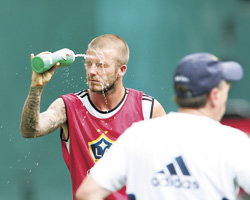Soccer seems to experience an exciting new surge in popularity about as often as Tacoma has a renaissance. Which is to say—on a regular schedule, as required by newspapers’ need for feature stories.
Last week brought another example, as the P-I purported to uncover a “soccer boom” in Seattle, one not seen “since 1976 when Pele and the New York Cosmos played the Sounders in front of 58,000 people in the Kingdome.” The evidence advanced by the reporter for said boom included the imminent arrival of Major League Soccer, as well as the big crowds recently drawn by international “friendly” matches at Qwest Field. But the article focused most on the supposed fact that more local bars are showing soccer on their TVs.
I’ve no idea if that’s the case. But if soccer’s showing up on more bar TVs, it’s likely because there are more TVs in bars. When you’ve got 12 screens at Floyd’s Place, sure, you can give one over to soccer. But I still don’t see anyone watching. Except, of course, at places like Fado and the George & Dragon—i.e., the old standbys, which is where the P-I had to go to secure the requisite photo of animated Euro fans. (It helped that there’s been a European championship going on the last few weeks.)
A more telling photo might have come from the Japanese place downstairs from our office, or the two Mexican places around the corner, where soccer is often on and nobody’s watching. I recently spent a lovely Saturday afternoon sitting at the bar at Café Presse—you know, that place where everyone soaks up the European ease and sophistication and pretends they’re in Paris. Of course soccer was on the telly for authenticity’s sake, but there wasn’t a damn person in the place watching it besides me. And it was a great game. (Liverpool beat Blackburn Rovers 3–1.)
Last month, on Father’s Day, my folks and I headed down to the All Nations Cup. It’s a big amateur soccer tournament pitting teams representing countries from around the world. From the event’s energetic marketing, I’d come to expect a big festive occasion, full of international goodwill, with immigrants bringing their native soccer passion to bear, and colorful traditions of fandom. When we arrived at the Starfire Sports Complex in Tukwila on a gorgeous day, the scene was a bit different. The crowd consisted of a handful of the players’ friends and relations clustered in “the stands” (i.e., some runty bleachers, about six rows high and 10 butts wide) along the sidelines; two sad booths offered “global” merch and cuisine; a pair of loudspeakers sat on the pavement blaring terrible Westernized ethnic music; and (in the closest thing to futbol mayhem) a handful of teenage Croatian girls in matching yellow T-shirts blew horns. The turnout was less than you’d see at an average kids’ game at Woodland Park—but without the intense, over-invested parents.
Then there’s the MLS. I think it’s great that we’ll be getting a Major League Soccer team, especially since Paul Allen promised a new “football and soccer stadium” in his pitch for taxpayer funds to build Qwest Field a decade ago. (Who can forget the TV ads featuring little girls running around, self-actualizing themselves with a soccer ball?) But I can guarantee you there won’t be 58,000 people showing up to see Sounders FC on any regular basis.
For one thing, the quality of play in MLS is just too weak. When an MLS highlight reel occasionally turned up during broadcasts of Euro 2008, it was like seeing a WNBA game suddenly break out during halftime at the NBA finals (sorry, ladies). I love soccer, and even I find MLS games boring. The best players in the game simply don’t play here—until they’re washed up, like Beckham.
The magic of the 1970s Sounders was unique to that time—a time before the Mariners and Seahawks—and is no more going to be recaptured than Fremont is going to become “quirky” again. Sure, soccer promoters can pack Qwest Field for exhibition games by bringing the circus to town, in the form of Manchester United or the Mexican and Brazilian national teams. But the soccer “boom” in America, which was already supposed to have arrived at least a dozen times over the past 20 years, isn’t coming on any faster now than the metric system.








